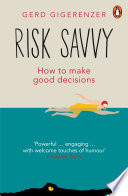

The first main idea of 'Risk Savvy' revolves around the importance of understanding risks in everyday life. The author emphasizes that risk is an inherent part of decision-making, and being risk-savvy means being able to assess and manage these risks effectively. This idea is grounded in the notion that many people have a poor grasp of probability and statistical reasoning, which leads to poor decisions. The book illustrates this point through various examples, such as how people often overestimate the likelihood of rare events and underestimate more common risks. By developing a better understanding of risks and probabilities, individuals can make more informed decisions, whether it’s in health, finance, or personal safety.
Continue readingAnother key idea presented in the book is the significant role that emotions play in how we perceive and respond to risk. The author discusses how fear, anxiety, and other emotions can skew our judgment, leading us to react irrationally to certain risks while ignoring others that may be more pressing. For instance, people may avoid flying due to fear of crashes, despite statistical evidence showing it is one of the safest modes of transportation. The author suggests that being aware of our emotional responses to risk can help us make more rational decisions and mitigate the impact of these emotions on our choices.
Continue readingStatistical literacy is a cornerstone of being risk-savvy. The book highlights how understanding statistics can empower individuals to interpret data more accurately and make better decisions based on that data. The author argues that many people lack the basic statistical knowledge necessary to understand the risks they face. For example, the book discusses common misconceptions about averages and probabilities, and how these misunderstandings can lead to poor decision-making. By improving statistical literacy, individuals can better evaluate risks and weigh the potential outcomes of their decisions.
Continue readingEffective risk communication is another critical theme in 'Risk Savvy.' The author stresses that how risks are communicated can greatly influence public perception and behavior. Misleading statistics, sensationalized media reports, and poor explanations can lead to misunderstandings about risks. The book provides examples of how clear and accurate communication can help individuals and communities make informed choices. The author also discusses the responsibility of experts and policymakers to convey risks in a way that is understandable and actionable for the general public.
Continue readingThe book offers various frameworks for decision-making that incorporate risk assessment. One of the main frameworks discussed is the idea of weighing the potential benefits against the risks involved in a decision. The author encourages readers to consider not just the worst-case scenarios but also the best-case outcomes when evaluating risks. This balanced approach helps individuals to make more rational decisions rather than being swayed by fear or overconfidence. Practical examples are provided to illustrate how these frameworks can be applied in real-life situations.
Continue readingLearning from past mistakes is a crucial aspect of becoming risk-savvy. The author emphasizes the importance of reflecting on previous decisions and their outcomes to improve future decision-making. This idea is rooted in the concept of experiential learning, where individuals can gain valuable insights from their experiences. The book encourages readers to adopt a mindset of continuous learning and to view mistakes as opportunities for growth rather than failures. This perspective can help individuals become more resilient and better equipped to handle future risks.
Continue readingLastly, the author discusses the importance of seeking expert advice when faced with complex risks. While individuals should strive to be informed and make their own decisions, there are situations where expert knowledge can provide invaluable insights. The book cautions against blindly following expert opinions but encourages readers to critically evaluate the advice they receive. By understanding the limitations and biases of experts, individuals can make more informed choices that align with their own risk tolerance and values.
Continue reading